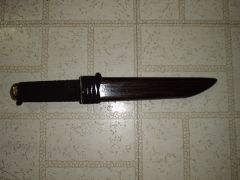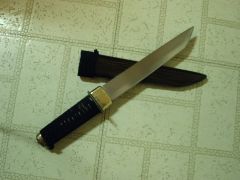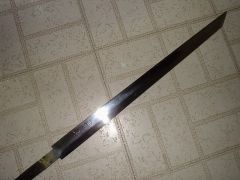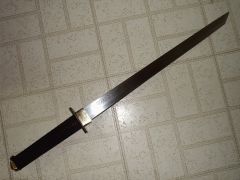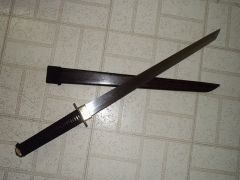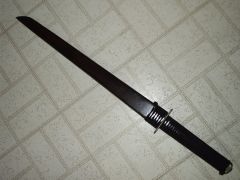
Graham Fredeen
Members-
Posts
179 -
Joined
-
Last visited
Content Type
Profiles
Forums
Articles
Gallery
Downloads
Events
Everything posted by Graham Fredeen
-
Here are the most recent pieces I have finished, both being commissioned work. A 28" straight-bladed wakizashi, and a 12" tanto. The overall blade length of the Wakizashi is 20", and the tanto has an 8" blade. Both are forged, 5160 spring steel, heat treated. I cast the brass collar and pommel pieces, which gave me a great deal of trouble, one of those situations where the right casting material would have made a difference. The scabbards and grips are both red oak, with an ebony stain, and then a black leather wrap. The Wakizashi blade is engraved with the japanese symbols for Aikido, as per request of the client. Comments, questions, criticisms all welcome.
-
-
-
-
That extra 0 makes a difference, I skimmed over it (read abrasive, saw 8 with some 0's, immediatly though of the 800, since 8000 isnt really much abrasive at all;) ). In the case of 8000, you are probably right, that wouldnt do much of anything, if anything to the finish, unless polish it up. And I did get where you were trying to go with the disks (granted the abrasive grit makes a difference now). The only issues I can see with that is getting them to form the exact angle you need for your edge, could pose some difficulty. Afterall, even if it is 8000, you dont want it to fold the edge over, rather than straighten it. But hey if you get a chance to try it out, you might as well, afterall, it probably could work, if set up right, and you could be on to a new big thing in the world of knife sheaths. Those woods you mentioned are great woods in general, and they look very nice finished up and uncovered. I wont use them under leather because of 2 main reasons, first, they look too good to cover up, and secondly they cost a lot more than your standard oak and oak will do just as well, so I figure I might as well use the oak, more economical. Then if I am selling the knife, I dont have to charge as much for it because I chose the more expensive wood, which cant be seen anyway. For something uncovered, I would definatly use the nicer woods. Tar Alderion
-
I am not sure about traditional waterproofing practices for wood off the top of my head, but what you mentioned could very well work. And, you probably could treat the inside, then just sand off the treatment where the seams are to be glued. You can use what ever wood you want under the leather really, but some woods hold up better than others, especially if it is a larger scabbard. I quite like oak for use in this manner, and as cores for the leather covered grips on blades. Oak lasts for just about ever, its strong and durable, and it wont break and splinter as easily as other woods since the grain structure is more refined and tends to compress quite a bit before fracturing. I am not sure about lining the sheath with any abrasives. I have lined a couple of sheaths with a soft felt typed material but thats about all. The problem with the abrasive material is it will ruin the finish, unless the finish is a linear grained, hand sanded with the same grit. I also dont think you would be able to get the abrasives to sharpen the blade in that manner, it would more likely sand away the edge, rounding it over, requiring the edge to be reground constantly. I would rather just pull out the stone every now and then and give it a sharpen. As a side note on blade sharpening, a thing I have found is that if you sharpen a knife before it is dull then it will stay sharp indefinatly. Meaning that if you lightly use a wet/oil stone on the edge after each use (or every few uses if light cutting is being done) then the edge will be maintained and it will stay as sharp as the day you first made/got it. Where as if you use a knife until it is dull, sometimes the only way to get the edge back (especially if it is a cheap knife) is to regrind the edge completly. TarAlderion
-
Candidquality I have done scabbards like the one you are descirbing. And you have the process down almost exactly. You start with your wood stock for the core, split it, then chisel and carve out the inside to fit the blade exactly, glue the pieces back together, sand and shape it to the desired finished shape, polyurethane, reverse stitch the leather, then cover it with the leather, wetting and applying, then wraping the leather to ensure good shrinkage. Some things I would recomend would be to first (if you arent planning on doing this already) is wait to carve out the core wood until you have the finished blade which will go with the sheath (couldnt tell if you were trying to do the scabbard before the blade or not from your wording). This way you can fit the sheath exactly to the blade with out excessive space which results in the blade being too lose, or the opposite problem of the blade being too large for the sheath and not fitting in, being too tight, which often results in ruining the blade finish and edge. Its easier to tailor the scabbard to the blade than trying to fit the blade to the scabbard (which I have never heard of anyone doing anyways). Another thing I would recomend is to treat the wood with some sort of polyurethane, lacquer, or other water proofing product to help protect the wood core from the moisture of the wet leather in shrinking, and any other moisture which may be trapped or find its way to the wood, potentially causing problems down the road. And Deffinatly use the thiner leathers, the thicker leathers dont stitch easily, leaving a huge bump where the seam is, they arent really flexable enough to reverse, and they wont shrink very much in comparison to the thinner leathers. I dont know if it would be better to do the leather tooling before or after putting the leather on the core. It would be easier to do before, but the shrinking process might distort/remove some of the tooling, not exactly sure though, I havent tried anything like that yet, but something to think about none the less. The other thing you might want to consider is once the leather is wet and applied to the wood, it is often necessary to wrap something tightly around it to ensure a good shrink and fit. Usually one can use string or heavy cord, the problem with that is that it will often leave imprints in the leather, but some wider strips of cloth instead would probably eliminate that issue. You can also do a bit of leather shrinking with a heat gun, but you must be careful, you can easily burn the leather, harden it to the point of cracking, you can burn your wood core underneath, etc. Its best to go with the water method in my opinion. Hope this helps a bit. ~The Lord Tar Aderion~
-
For the most part I heat treat all of my blades (save some of the stock removal ones, the stock itself is usually hard enough). But yep, full hardening and temper for this one. You could probably get by with the 1080 normalized due to the higher carbon content, but since most of this blade is in the lower end of the high carbons and a mild spine, I figure its best to give a good heat treat to maximize performance and quality. As for the runes, dont know why I didnt think to mention them before. They are nordic, and on one side it says "Honor" and on the other (which I didnt post a pic of) it says "Power." On another good note, I finally accumulated enough spare change to go get some more propane. So hopefully I can get that soon and make some progress on that billet. I think I am going to shoot for about 64 layers with it, and I have decided to do a serpantine ladder pattern. And I think with the mass of the billit now, by the time I get all the folding done and forged to shape I should have enough to do a short sword. And I should also be finishing up some other simple knives in the near future. Will post progress. Tar Alderion
-
Thanks all. Rantalin, for the pommel, what I did was once I had everthing fitted properly, I peened the tang slightly, good enough for it to hold everthing, then I gave it a quick zap with the arc welder to build up some more metal (as well as to ensure a permanant fixation for the entire hilt assembly). Then I ground down the weld build up into the shape of the rest of the pommel style, sanded and polished, giving the appearance of no tang and just a solid pommel piece. I also did the heat treat on 4 smaller knives I have in the works today. I hope to have them all done in the next couple of weeks. I also have a large 3 steel billit that I have been working on (currently 18 layers), which I think I am going to try to do a ladder pattern with. But that will take some time before I make much progress with it, I still have to decide on the layer count I want, and how big I want the blade to be. At the moment I could probably manage a decent sized sword with it, but the more layers, I do the smaller the blade due to the loss of mass to fire scale. I will have to see about it once I finish the other blades I have in the works. Tar Alderion
-
Well, I just finished this dagger today and thought I might as well show you all and see what you guys think. The blade is pattern welded with a spine of braided rebar, and the edge composed of 1060/1075. The guard and pommel are of mild steel, the grip is red oak with bone inlay and rune script. This was just something I was messing around with a bit and kind of experimenting with some different things (like if the large amounts of rebar I have laying about would be worth trying to incorporate into blades and what not). The pattern is not really impressive at all (and most of the small weld lines cant be seen in the compressed pictures anyways) but hey for just messing around, I suppose its not too bad. Tar Alderion
-
Thanks Jens. So far there hasent been any nay-saying (least non I have heard ). I like to design my weapons, first to be functional, if its not functional, I dont make it. But then I also like to throw in a bit of originality and new concepts. Plus I also do a lot of historically based designs, or use historical weapons as a basis, then modify to make something of my own. Tar Alderion
-
I can say that I have never done any machining, nor claimed to have done so. I have never worked a lathe or mill, and I dont even know where to start (I could figure out how to turn it on and move some stuff, but thats all). Someday, when I have a bit more money I might make an effort to learn and obtain equipment, but not yet. The most I have done is about what you have said, a drill press, some files, and a bit of grinding, and that is about where my knoweledge about machining stops. You are definatly thinking of someone else besides me. So, you are forgiven, I just hope things like this dont happen in the future, between anyone here. I know how irritating and annoying an arrogant person can be, who claims to be an expert on something, but really knows nothing. But even then, I dont think the purpose of this site is to jab at them or cut them down even. I think its far more effective to just correct the misinformation so others know the truth and arent lead astray, and let the arrogant, all knowing fool believe what he wants. If he is smart, he will see the error in his ways and if he isnt, then thats his loss and problem. Insults, just create unneeded confilct and confrontation. And thanks for the backing Dodge. Tar Alderion
-
There is no need to be contemptuous Thomas. You may have more knoweledge and experiance than me in this matter, but that is no reason to ridicule and post jabs like, "Tar if you know 1/10 as much as you claim you would know this!" Its not necessary or appropriate for that matter. To begin, I havent "claimed" anything, thats being a bit assumptious. I have never said I know everything, I know a decent working amount about a lot of things, but not even close to the amount of information out there, it would take many many lifetimes to learn it all if you even could. No one knows everything about a subject. like in this situation, I know that iron will absorb carbon (like with things like graphite, and throwing in charcoal when case hardening) , and I know that diamonds are formed from carbon under extreme pressure and heat, but I didnt know if the stability of diamonds would break down enough in forging heat to allow carbon absorbtion into the steel. I havent worked with diamonds, cant afford to, so I havent researched using them, plus most of what is out there about diamonds and blades is myth and fantasy. So, I speculated and I presented it as speculation, not fact. Thats no reason to throw in comments like that. This place is here for the puropse of sharing and learning, so if someone is wrong about something, I dont think they should be attacked.
-
That is basically what I said, about the micro serrations, you got the idea. Now if you took the diamond dust and just welded around it (kind of making pockets or deoposites withing the structure of the blade) You might be able to get it to work. Hopefully the powder would bond with itself and not just pour out of the openings. The only other problem I could see with the diamond core type of idea (which is like what Me Miller mentioned Daryl Mier attempting) is that if you could get it to work, the blade might be extremly brittle and break on you. There is a lot of misunderstanding that occurs with diamond. Diamond is the hardest substance on earth, but that does not mean that it is unbreakable. It just means that the only thing which can scratch or cut a diamond is diamond itself. But if you were to take a hammer and smack a diamond with it, it would break and crush. So thats why I am thinking if you were able to get a diamond core done, being long and thin for the blade, it would probably fracture and break apart with stress. As for open welds, the main problem with open welds is they can compromise the structure and strenght of the blade. You might be able to get by with a couple on the surface and what not, but if there are many and they go completly through, the blade could break especially if the other welds are not sound, or end up pulling apart. Oh, and the bigest problem with something like this is the extensive cost. The moment you start pulling diamonds into the picture, industiral or not, you are talking some $$. And if it didnt work, all the $$ and work put into it would be wasted. Tar Alderion
-
Chuck, I do not ever recall saying that there was no carbon in the edge, I just ment to say that there is no carbon crystals which form "on" the edge (as in on top of, as a separate part, which is what AM's wording sounded like). That is the only thing I was attempting to get at. As for the rest and what you have said, that is completly correct. The edge holding ability of the steel lies completly on carbon content within the crystaline structure. Pure iron may be brought to an edge, but it lacks the ridigity to stay sharp, but with the addition of carbon into the steel, the hard carbon crystals provide the toughness for a maintainable edge. I am with you completly on that. Same with the grain structure, the smaller the better. That is what the heat hardening does, it cools very quickly causing smaller grain, if it cooled slowly you would get larger grain. The same concept applys to all minerals. I did not mean to convey anything else, so if it came off that way, my mistake and apologies there. Hope this clears up everything I suppose it is difficult to correspond ones exact meaning in a post sometimes, therefore resulting in miscommunication. No need to apologize. I guess I just felt a bit irritated because your post seemed to portray a lack of knoweledge on my behalf, where that is not the case. No one likes to be misrepresented I suppose. But hey no big deal. A.M. you are speaking of the "micro serrations" which I slightly mentioned earlier. If an edge is completly smooth, it will not cut (maybe it would with a heck of a lot of pressure, but you sure wouldnt call it sharp). The micro serrations act kind of like a saw, but on a much finer scale. I however, believe that most of the micro serrations are caused by the grit used within grinding, not necessarly just carbon "crystal" protrusions since the carbon is failry well bonded on a molecular level with the iron so as not to form pur carbon deposites (but there would be some carbon crystals (on a microscopit level) as a part of the entire edge which would be exposed, along with the iron.) The grinding belt, stone, or whatever you use to sharpen is composed of a bunch of grains of a substance (ex. aluminum oxide for most standard belts). These scratch and remove material by gouging into the steel surface, and at the edge the small gouges come together and leave the serration stlyed edge. And the carbon crystals would also tend to be removed at a slower rate than the iron itself being harder, resulting in the "protrusions" which could be what your source was getting at. So I would say that the serrations are not necessarly "caused" by the carbon crystals, but rather in the sharpening process itself, which forms the entire steel composition that way. Now somewhere I read something that spoke about being able to orientier the grain structure of the steel in order to improve the existance of the micro serrations. Which I think that tends to occur naturally in the forging process anyways as you hammer in the beveling. Not entirly sure about any special technique to do it though. It might not have any basis either, could be one of those myths, but it does seem plausable. Tar Alderion
-
Yes, please tell me what you think is wrong with my post, because I have no idea what you are refering to. I have researched extensivly on heat-treating and metallurgy, and I do not state "concieved opinions," I speak from the factual information which I have learned from. And just in case you misinterpreted what I said, I will provide clarification. The statement which I made was refering to A.M.'s comment "I know that one thing that contributes to edge cutting ability is carbon crystals on the surface of the edge(or is that not true?)." Now in A.M.'s comment, the part about carbon crystals on the surface of the edge is what I was primarily adressing, not carbon content in the crystaline structure of the steel. In all of the blades I have made (and I have made many) I have never found pure carbon crystals on the surface of the steel after heat treating and grinding an edge. This is not saying that greater carbon content within the steel composition at the edge will not increase the edge holding ability of steel, it is saying that "carbon crystals" do not form on the "surface of an edge". The carbon crystals instead form within the crystaline structure of the steel itself and are part of the grain structure of the steel itself, not as a seperate part on top. Durring the heat treating process the entire crystaline structure of the steal is changed when rapidly cooling from the austenite state to that of martensite. The more rapid cooling results in a more complex crystaline structure (martensite) and a harder steel and the more carbon present in the steel, the harder the steel may become. This being said, I stand by what I said that carbon crystals on the surface of an edge do not aid in cutting ability (because I have yet to see any blade with carbon crystals actually on the edge itself), rather the carbon content and crystaline structure of the steel at the edge provide the hardness requried for a superior edge. With the harder steel one can then shape the proper edge to the proper angles to provide a quality cutting edge, as well as have a thinner edge with out deformation due to softness. I will also say that I find your comment to be frankly insulting and based on assumptions about what you think I know and what you think I dont, especially when you yourself have not even stated what portion of my post was incorrect. The more prudent thing to do would have been to point out the specific errors in my post, then suggest a correction and not state that I spoke out of "concieved opinion." As if I just made the whole dang thing up off the top of my head.
-
I am going with Tyler on this. I dont think you would be able to weld the diamond dust into the steel. I believe that diamonds form under alot more heat and pressure than a forge could produce, and at those temps, the steel would be molten. So due to that I doubt you could get the diamonds to contribute positivitly to any form of cohesion in a forge weld, they would most likley interfer as a contaminant. As for the edge cutting ability, I have not personally heard of carbon crystals on the edge resluting in a superior cut. The edges of a blade are ground in, so therefore, any carbon crystals which could have formed durring the forging process (which I dont think occurs either, just carbon and iron oxides in the form of fire scale not pure carbon crystals) would be ground away and removed. The cutting ability of an edge lies in its shape, angle, and steel hardness primarily, and some on the grain orientation of the steel. A harder steel (with more carbon) will hold its shape much better, allowing it to be ground much thinner and more precise, creating a great cutting edge. The thinner the angle the edge is ground at will also result in a sharper edge. And finally in some of the forging process it is possible to cause the grain of the steel to become orientierd somewhat perpendicularly to the edge, which creates sort of micro-serrations which makes a better cutting blade. But I dont think carbon crystals on the edge have anything to do with it. Now if you did want to make a blade with diamonds in it, I suppose you could try to place diamonds in a mold, and cast a steel blade, causing the molten steel to flow around the diamonds and the result would be a cast blade with imbeded diamonds, but I dont know how that would work exactly. Tar Alderion
-
Oil Quenchant for Heat Treating
Graham Fredeen replied to Graham Fredeen's topic in Heat Treating Knives, Blades etc
Well, A.M. as for your punch and water hardening. If your water quenchant was warm/hot that could have slowed the quench enough not to cause cracking, or if you quenched below the critical. Or you were just fortunate not to have a crack form. Plus you mentioned tempering, if you tempered enough (500 F + or when it starts to turn blue) the punch should work just fine. Plus you said you hot punch, everytime you punch you heat up the punch itself, and if it gets hot enough you temper it. If you have flattened the tip multiple times that indicates that the heat treatment has gone due to lots of heat (either in the initial tempering or through its life of punching.) I have experimented with 5160 and water quenching a few times and the first time I quenched a section of it from the critical, I got a crack. The rest of it was brittle enough to break over the edge of the anvil. I also have tried heating the water and then quenching, this tended to reduce the tendency for cracking but it did not help the brittleness much, which means a good tempering is needed. But for the most part, I find its best just to use the oil and not have to worry. Tar Alderion -
Oil Quenchant for Heat Treating
Graham Fredeen replied to Graham Fredeen's topic in Heat Treating Knives, Blades etc
Sandpile is right A.M. If you quench 5160 in water you will crack it, unless you are extremly lucky, but in most cases it will crack. And if it doesnt crack it will be brittle beyond any use. You must use oil. And, if you harden a blade and it does not need tempering afterwards that means it did not harden in the first place. You must always temper or your blade will not be of any service and will break with the least amount of stress. When I get some more $$ I might check out that soybean oil, sounds good. Tar Alderion -
Oil Quenchant for Heat Treating
Graham Fredeen replied to Graham Fredeen's topic in Heat Treating Knives, Blades etc
Cost and avaliability was the main issue I faced. I think I might go hit up one of the fast food places about here and see what I can do. That sounds like the best route. I thought of checking with an automotive repair/oil change place to see about that, but I really didnt want to mess with automotive oil, as the various reasons stated by Tyler and Nolonao. Should have though of the fast food places myself, but didnt think of it. Anyway, thanks for the ideas I should be able to make something work now. Tar Alderion -
Greetings all. I have a qestion in reguards to obtaining oil for heat treating blades. As I have increased my blade production and blade size I realize that I need to get a large quantity of oil for quenching durring the heat treatment. Previously to this I was using a small amount of oil (say about a gallon) for quenching, as I was only doing smaller knives, one at a time. But with larger blades and more blades being treated at a time, I need some larger amounts of the stuff to prevent it from reaching flash point and causing a fire, and to ensure a full quench for the entire blade. So, my question is, firstly what sort of oil do you use for quenching, where do you get it, and the price (roughly, I know it will vary per region)? I know where to get smaller amounts of vegetable oil, peanut oil, and automotive oils, and the like, but by the time I purchase the quantity I need (probably 5-10 gallons or more possibly) I will have spent a large amount of money, which is something I lack at the moment. So I suppose I am looking for the cheapiest way to go to get the job done. Any help is greatly appreciated. Tar Alderion
-
Thanks Victor. I have about 4 more knives ready for heat treating, but I need to get some more oil to quench in. Anyway, when I get them done, I will post pictures. ~Tar Alderion~
